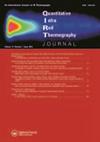基于特征减少和热谱分类的癌症乳腺癌肿瘤检测
IF 4.9
3区 工程技术
Q1 INSTRUMENTS & INSTRUMENTATION
引用次数: 14
摘要
摘要患有乳腺恶性肿瘤的患者,如果在早期发现,生存机会会更好。据观察,对乳房体温图纹理特征的分析有助于在更大程度上为诊断提供正确的信息。在这项研究中,考虑了56名受试者的乳房体温图,这些受试者在数据库Mastology Research(DMR)视觉实验室有温度记录。此外,从这些图像中提取灰度游程长度矩阵(GLRLM)和灰度共生矩阵(GLCM)中的纹理特征。特征的相关性给出了变量之间的线性关系,这有助于分析变量之间的定量关系。通过使用无监督特征约简技术,即主成分分析(PCA)和自动编码器(AE)来选择特征。观察到所选择的特征与检测健康和不健康乳房之间的异常相关。然后将不同的分类器,即支持向量机、决策树、随机森林、K-NN、线性回归和模糊逻辑应用于所选特征,以检测乳腺恶性肿瘤的存在。在所有分类器中,已观察到具有PCA的随机森林(RF)在对良性和恶性肿瘤进行分类时产生95.45%的准确率。本文章由计算机程序翻译,如有差异,请以英文原文为准。
Detection of breast cancer tumours based on feature reduction and classification of thermograms
ABSTRACT The patients having malignant breast tumours if detected in early stage have a better chance of survival. It is observed that the analysis of the texture features of the breast thermograms helps in providing the right information for diagnosis to a greater extent. In this study, the breast thermograms of 56 subjects having temperature recordings available at Database Mastology Research (DMR), visual labs are considered. Further, the texture features in the Gray level Run Length Matrix (GLRLM) and Gray level Co-occurrence Matrix (GLCM) are extracted from these images. The correlation of features gives a linear relationship between the variables that help to analyse the quantitative relationship between the variables. The features are selected by using unsupervised feature reduction techniques, i.e. Principal Component Analysis (PCA) and Autoencoder (AE). The features selected are observed to be relevant in detecting the abnormality between healthy and unhealthy breast. Different classifiers viz. support vector machine, decision tree, random forest, K-NN, linear Regression, and fuzzy logic are then applied to the selected features for detecting the presence of malignancy in breast. Among all the classifiers, Random Forest (RF) with PCA has been observed to yield an accuracy of 95.45% in classifying the benign and malignant tumours.
求助全文
通过发布文献求助,成功后即可免费获取论文全文。
去求助
来源期刊

Quantitative Infrared Thermography Journal
Physics and Astronomy-Instrumentation
CiteScore
6.80
自引率
12.00%
发文量
17
审稿时长
>12 weeks
期刊介绍:
The Quantitative InfraRed Thermography Journal (QIRT) provides a forum for industry and academia to discuss the latest developments of instrumentation, theoretical and experimental practices, data reduction, and image processing related to infrared thermography.
 求助内容:
求助内容: 应助结果提醒方式:
应助结果提醒方式:


